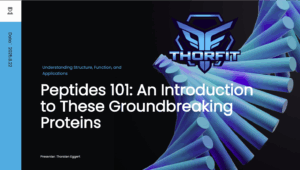What Are Peptides?
Peptides are short chains of amino acids—typically 2 to 50 linked together—that act as building blocks for proteins. Think of them as “mini-proteins” that send precise signals in the body. Unlike full proteins (which can have hundreds or thousands of amino acids), peptides are smaller, more targeted, and often easier for the body to absorb and utilize.
Key Characteristics:
Molecular Weight: Usually under 5,000 Daltons, making them bioavailable.
Natural vs. Synthetic: Many occur naturally (e.g., insulin is a peptide hormone), but synthetic versions are engineered for specific effects, like muscle growth or skin repair.
Functions: They mimic or enhance biological processes, such as hormone regulation, immune response, or tissue repair.
Peptides aren’t new—insulin, discovered in 1921, was one of the first therapeutic peptides. Today, they’re exploding in popularity for anti-aging, athletic performance, and medical treatments.
Why Peptides Matter for the Masses
In my view, peptides are the future of personalized medicine. They’re more specific than traditional drugs, with fewer side effects when used correctly. For example:
Therapeutic Uses: Treating diabetes (e.g., GLP-1 agonists like semaglutide), wound healing (e.g., BPC-157), or cognitive enhancement (e.g., nootropic peptides like Semax).
Performance and Wellness: Bodybuilders use them for recovery (e.g., TB-500), while biohackers leverage them for longevity (e.g., Epitalon for telomere extension).
Accessibility: Once elite-only, peptides are now producible at scale, potentially affordable for everyday people—if we navigate regulations smartly.
Administration is where expertise shines—get it wrong, and efficacy drops or risks rise. We’ll deepen this in future lessons, but start here:
Routes of Delivery:
Subcutaneous Injection (SubQ): Most common for peptides like growth hormone releasers (e.g., CJC-1295). Use insulin syringes (0.3-1mL, 29-31 gauge) for shallow injections into fat tissue (abdomen, thigh). Pros: High bioavailability (90-100%). Cons: Needle phobia.
Intramuscular (IM): For faster absorption, like in deltoids or glutes. Less common for peptides due to potential discomfort.
Oral/Sublingual: Rare, as stomach acids degrade most peptides. Exceptions include stable ones like PT-141 (for libido) or nasal sprays (e.g., Melanotan II).
Topical: For skin peptides like GHK-Cu, applied as creams.
Dosing Principles:
Start low: Micro-dosing (e.g., 100-500mcg) to assess tolerance.
Frequency: Many require daily or bi-weekly injections (e.g., Ipamorelin at bedtime to mimic natural GH pulses).
Reconstitution: Lyophilized (freeze-dried) peptides need bacteriostatic water. Mix gently—never shake—to avoid denaturing.
Safety Essentials:
Sterility: Always use alcohol swabs, fresh needles.
Storage: Refrigerate reconstituted peptides (2-8°C); freeze-dry unmixed ones last years.
Track bloodwork (e.g., IGF-1 levels for GH peptides) to avoid imbalances.
Pro Tip: As an aspiring expert, practice on oranges for injection technique before self-administering.
Introduction to Selling Peptides
Selling peptides isn’t just commerce—it’s about empowerment. But it’s regulated territory. We’ll cover marketing ethics and strategies later, but basics:
Who is it for?
- Bio-hackers
- Weightloss
- Longevity
- Muscle Building
- Tanning
- Libido
If you want to know more about these wonderful compounds, click the link below… and we’ll send you Peptides 101, an introduction to these Groundbreaking Proteins





